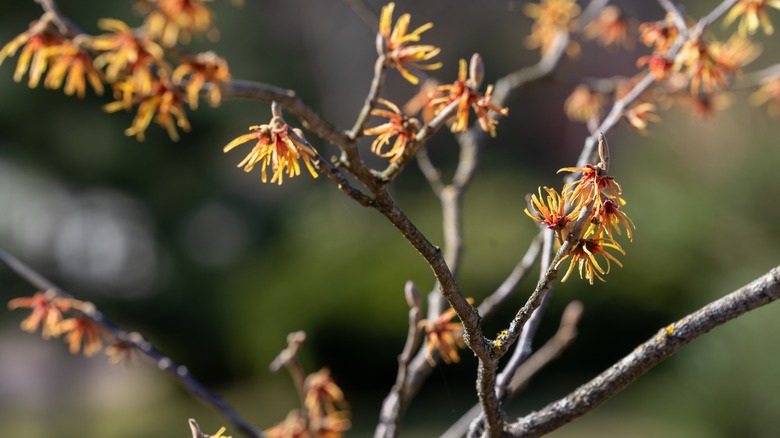Deer are equally beloved and derided by gardeners across the U.S. Looking out through the kitchen window and glimpsing a sweet fawn and its mother in your garden is a joyous sight. Perusing your beds on a spring morning to find the leaves, twigs, and bark chewed to bits, not so much. If you’re looking for a pretty shrub that’s less attractive to deer, consider cultivating the hardy vernal witch hazel. Witch hazels, generally, are considered deer tolerant, though this depends somewhat on the season and the characteristics of local deer populations.
Witch hazel is in the Hamamelidaceae family, with species native to North America and Asia. Vernal witch hazel (Hamamelis vernalis) is one of two North American witch hazel species — the other being Hamamelis virginiana (common witch hazel). It’s also commonly known as Ozark witch hazel because it’s native to Missouri and Arkansas. The plant is distinctive in that it has smaller (though just as fragrant) blooms than its cousins and is slightly more diminutive — up to 10 feet tall and 8 feet in diameter at maximum. American gardeners favor vernal witch hazel for its magnificent golden fall leaf displays and yellow-orange early spring flowers, hence its other common name, spring-blooming witch hazel. It’s also one of the companion plants that thrive next to hardy azaleas.
How deer-proof, really?

Vernal witch hazel and its close cousin, common witch hazel, feature on numerous respected deer-resistant plant lists. North Carolina State University’s Deer Resistant Plants list categorizes the Hamamelis species (which includes vernal witch hazel) under landscape trees that are “occasionally damaged.” The entry for vernal witch hazel specifically lists the plant as “resistant to challenges” from deer. Rutgers New Jersey Agricultural Experiment Station (NJAES) includes common witch hazel in its list of landscape plants rated by deer resistance. This bodes well for relatives like the Ozark. The Bowman’s Hill Wildflower Preserve lists Hamamelis vernalis (vernal witch hazel) as “deer tolerant/resistant,” stating, “Deer tend to avoid plants with aromatic foliage, tough leathery, hairy and/or prickly leaves, or plants with milky latex or sap.” Indeed, vernal witch hazel has large, coarse leaves that sound rather unpalatable.
No plant is completely deer-proof. While witch hazel species aren’t a preferred part of their diet, deer will give these plants a nibble if they get desperate — say, during the winter when other food sources are scarce or covered in snow or if there’s lots of competition for food in a specific area. Conversely, a few sources state that witch hazel is, in fact, damaged by deer. “Deer eat the shoots and leaves,” an entry on the plant on the Missouri Department of Conservation website asserts. An article published on the official Town of Washington Grove portal says that deer like to rub against the trunks of witch hazel plants.
Get your tree
It appears mature plants recover well from such disturbances. A 2002 study published in Natural Areas Journal found that witch hazel could “produce rapid sprout height growth and many large leaves” in response to predation by deer, giving it an advantage over other forest species. Saplings and newly planted shrubs are more vulnerable; protect them with natural deer repellent or fencing.
If you’re gardening in US Hardiness Zones 4 through 8, you can grow vernal witch hazel. Purchase saplings or seeds from a reputable nursery to ensure healthy plants. Sheffield’s Seeds, established in New York State in 1978, has packets of 25 Hamamelis vernalis seeds for $4.95 each. They note that plants may take 2 or 3 years to germinate after sowing. Don’t have the patience for seeds? Purchase a full vernal witch hazel shrub in a 3-gallon pot for $73.99 from Plant Addicts. Plants from this grower come with a one-year warranty. If you’re in Missouri, you may be able to get a tree for free! October dates are still open for a handful of Fall 2024 Project CommuniTree pickup locations, and witch hazel is on the list of available plants.